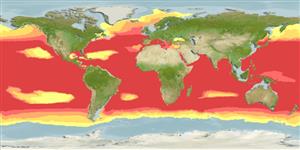Common names from other countries
Environment: milieu / climate zone / depth range / distribution range
Ekologi
Batipelagis; kisaran kedalaman 200 - 1000 m (Ref. 843). Tropical
Cosmopolitan, tropical and subtropical waters.
Length at first maturity / Size / Weight / umur
Maturity: Lm ? range ? - ? cm Max length : 11.5 cm ML jantan/; (Ref. 104052)
Minimum depth from Ref. 110525. Cosmopolitan (circumglobal) in tropical and subtropical waters. Paralarvae epipelagic; adults descend to mesopelagic and bathypelagic depths, undergo strong diel vertical migrations (Ref. 97142).
Life cycle and mating behavior
Kematangan | Reproduksi, perkembang biakan | Pemijahan | telur-telur | Fecundity | Larva
Members of the class Cephalopoda are gonochoric. Male and female adults usually die shortly after spawning and brooding, respectively. Mating behavior: Males perform various displays to attract potential females for copulation. During copulation, male grasp the female and inserts the hectocotylus into the female's mantle cavity where fertilization usually occurs. Life cycle: Embryos hatch into planktonic stage and live for some time before they grow larger and take up a benthic existence as adults.
rujukan utama
Acuan | Koordinator | mitra
Turgeon, D.D., J.F. Quinn Jr., A.E. Bogan, E.V. Coan, F.G. Hochberg, W.G. Lyons, P.M. Mikkelsen, R.J. Neves, C.F.E. Roper, G. Rosenberg, B. Roth, A. Scheltema, F.G. Thompson, M. Vecchione and J.D. Willams. 1998. (Ref. 1667)
Status IUCN Red List (Ref. 130435)
status CITES (Ref. 108899)
Not Evaluated
Not Evaluated
penggunaan manusia
| FishSource |
Alat, peralatan
Sumber internet
Estimates based on models
Preferred temperature
(Ref.
115969): 7.4 - 15.3, mean 10.4 (based on 938 cells).
